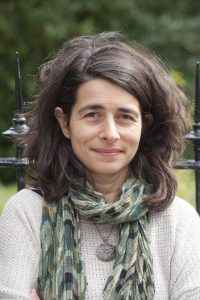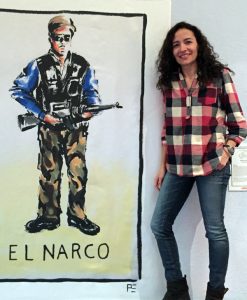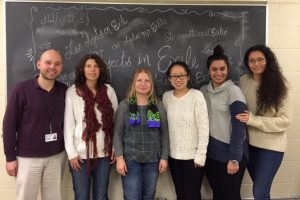Translation and the Arts
Toronto, Canada, March 5, 2016
7th Annual Glendon Graduate Conference in Translation Studies:
Toronto, Canada, March 5, 2016
This one-day multilingual event invites students, scholars, artists and professionals to come together to question the interplay between the human imagination and our diverse forms of cultural expression. Scholarly presentations will be highlighted by an art exhibition and theater performance. For more information, please view our program.
We are pleased to welcome Dr. Şebnem Susam-Saraeva as our keynote speaker. Professor Susam-Saraeva is Senior Lecturer in Translation Studies at the University of Edinburgh. She will be presenting her work on translation and popular music.
 Şebnem Susam-Saraeva is a Senior Lecturer in Translation Studies at the University of Edinburgh, Scotland, U.K. Her research interests have included gender and translation, retranslations, translation of literary and cultural theories, research methodology in translation studies and internationalization of the discipline. She is the author of Translation and Popular Music. Transcultural Intimacy in Turkish-Greek Relations (2015) and Theories on the Move. Translation’s Role in the Travels of Literary Theories (2006), and guest-editor of Translation and Music (2008) and Non-Professionals Translating and Interpreting. Participatory and Engaged Perspectives (2012, with Luis Pérez-González). She acted as the co-vice president of the International Association for Translation and Intercultural Studies (IATIS), between 2010-2015, and is a Steering Committee Member of ARTIS (Advancing Research in Translation and Interpreting Studies).
Şebnem Susam-Saraeva is a Senior Lecturer in Translation Studies at the University of Edinburgh, Scotland, U.K. Her research interests have included gender and translation, retranslations, translation of literary and cultural theories, research methodology in translation studies and internationalization of the discipline. She is the author of Translation and Popular Music. Transcultural Intimacy in Turkish-Greek Relations (2015) and Theories on the Move. Translation’s Role in the Travels of Literary Theories (2006), and guest-editor of Translation and Music (2008) and Non-Professionals Translating and Interpreting. Participatory and Engaged Perspectives (2012, with Luis Pérez-González). She acted as the co-vice president of the International Association for Translation and Intercultural Studies (IATIS), between 2010-2015, and is a Steering Committee Member of ARTIS (Advancing Research in Translation and Interpreting Studies).
he keynote presentation will focus on how the performance of popular music, as well as its reception, can be influenced and shaped by translation and other interlingual activities. It will first offer an overview of the phenomenon by discussing music’s various forms of materiality and the accompanying forms of translation. It will elaborate on what non-translation of lyrics may signify within a particular socio-political context, how translation and music may interact on paper (e.g. album inserts), and how popular music may be consumed on digital platforms through the circulation of translations of lyrics.
The talk will then concentrate on a particular form translation may take within the context of popular music: global cover versions. These are cover versions of songs which are sung in a different language than the original. It will be argued that the latter coalesce into a phenomenon which seems to fall between the cracks of academic disciplines. Neither popular music studies nor translation studies seems willing to own it fully as worthy of study, despite its prevalence as a means of contemporary intercultural import/export. The former, dominated as it is by an interest in Anglophone popular music and its travels across the globe, has little to offer in the way of research on interlingual remakes and prefers instead to concentrate on intralingual cover versions from different time periods. The latter, anxious as it is in demarcating its disciplinary borders around the notion of translation as ‘transfer of meaning’, finds it challenging to take up cases of interlingual give-and-take where there is little or no transfer of meaning. The talk will conclude by giving examples from a particularly noteworthy case of global cover versions: a Turkish song which crossed the borders of more than 20 languages and many more countries across the globe since 1997.
The graduate students of the School of Translation at Glendon College, York University, are pleased to announce the Seventh Annual Graduate Student Conference in Translation Studies to be held on Saturday, March 5, 2016 at Glendon College in Toronto, Canada.
Translation is a site for creative activity that operates within dynamic fields of linguistic and cultural contact. This site opens roads into inquiries on how translation operates within the arts and how the arts operate within translation. Translators and interpreters can be viewed as playing the role of artists, while artists themselves embody many of the singularities that characterize the translator’s task. Within the shifting multimedia landscape of the digital age and an era of highly globalized cultural production it is of value to question the interplay between the human imagination and our diverse forms of cultural expression.
We invite students, scholars, translators, artists and critics to join us in sharing ideas that explore the interdependence of translation and the arts; how this relationship has manifested itself throughout history; and how it is developing in an age of rapid globalization, technological innovation and values that celebrate cultural diversity. The questions we put forward to spark this discussion include the following: how are forms of artistic expression, ranging from the literary, musical, visual, and performance influenced and shaped by translation? How does translation figure in the creative process and within the mediums of artistic productions? In what capacities do translators engage with art and do artists engage with translation? Where do critical theories from both domains intersect and how can they serve one another?
Topics for papers and posters can include, but are not limited to the following:
These and other related issues will be addressed at this one-day multilingual event, which will include a series of individual presentations (20 minutes each) and other related activities. Interested persons are invited to submit proposals of 250-300 words in English, French or Spanish by Monday, January 4, 2016 by filling out the form below or by emailing transconf@glendon.yorku.ca. Please ensure that you include the title of your submission, your name, affiliation if appropriate, email address and any tech or accessibility requests. Selected papers will be considered for publication. We may be able to provide simultaneous interpretation to and from Arabic, English, French, Mandarin, Portuguese and Spanish at the conference.
Les étudiants et étudiantes du programme de maîtrise de l’École de traduction sont heureux d’annoncer le septième colloque annuel en traductologie qui se tiendra le 5 mars 2016 au Collège universitaire Glendon de l’Université York, à Toronto.
En tant qu’activité opérant au cœur même d’échanges linguistiques et culturels dynamiques, la traduction se veut une plateforme idéale pour l’expression créative. Ainsi, il semble naturel de s’interroger sur la relation qu’entretiennent l’art et la traduction : quand et comment la traduction intervient-elle en matière d’art, et vice versa? De même, alors que les traducteurs comme les interprètes peuvent être perçus dans l’exercice de leur activité comme des artistes, le métier d’artiste fait, lui, appel à de nombreuses compétences semblables à celles qui caractérisent le traducteur. Dès lors, dans le contexte de la mondialisation et d’une ère numérique constamment changeante où la production culturelle fleurit à l’échelle globale, la question des relations existant entre l’imagination humaine et ses différentes formes d’expression suscite un intérêt tout particulier.
Nous chercherons ensemble à découvrir et à examiner les différents points, dans le temps comme dans l’espace, où se rencontrent l’expression artistique et la traduction. Comment l’art et la traduction ont-ils interagi au cours de l’histoire? Comment ces interactions évoluent-elles au XXIe siècle, à l’ère du digital et de la mondialisation où l’innovation technologique et la diversité culturelle se trouvent au centre des enjeux? Plus spécifiquement, comment les différentes formes d’expression artistique, qu’elles soient littéraires, musicales ou visuelles ont-elles influencé la traduction? En quoi, à l’inverse, ces formes d’expression artistique se sont-elles laissé façonner par la traduction? Où la traduction se situe-t-elle dans le processus créatif? Comment opère-t-elle au sein des divers médias de production artistique? Dans quelles mesures le travail du traducteur l’amène-t-il vers l’art et vice versa? Où se croisent les théories critiques des deux domaines et en quoi peuvent-elles profiter à la traduction comme à l’art? C’est avec l’espoir qu’ils se poseront ces questions, et d’autres encore, que nous convions chaleureusement tous ceux dont l’expérience ne manquera pas d’enrichir les échanges : étudiants, chercheurs, professionnels de la traduction, artistes et critiques d’art sont donc vivement encouragés à partager avec nous leurs contributions.
Les propositions (communications, affiches, etc.) pourront couvrir plusieurs types de sujets, dont les suivants:
Les sujets ci-dessus et autres points connexes seront traités lors de cette journée qui se veut multilingue et inclura des communications individuelles d’une durée maximale de 20 minutes, ainsi que d’autres activités. Nous vous invitons à nous faire part de vos propositions de communications (250 à 300 mots) en français, anglais ou espagnol d’ici le lundi 4 janvier 2016. La proposition pourra être soumise à l’adresse transconf@glendon.yorku.ca. Veuillez fournir le titre de votrecommunication, vos coordonnées, vos besoins informatiques, vos besoins en matière d’accessibilité, ainsi que le nom de votre programme d’étude et de votre université, le cas échéant. Certaines contributions pourront être retenues aux fins de publication. Lors de la conférence, des services d’interprétation simultanée pourraient être offerts entre les langues suivantes: l’anglais, l’arabe, le français, le mandarin, le portugais et l’espagnol.
Invitamos a todos aquellos interesados: estudiantes, académicos, traductores, artistas y críticos, a participar en este foro en el que se intercambiarán ideas que reflexionen sobre la interrelación entre la traducción y el arte; sus manifestaciones a lolargo de la historia, y su evolución en una época de constantes innovaciones tecnológicas que celebra la diversidad cultural. Algunas de las cuestiones que planteamos son: ¿de qué forma las diferentes manifestaciones artísticas se ven influidas y moldeadas por la traducción? ¿Cuál es el papel de la traducción en los procesos creativos y en los medios de producciónartística? ¿De qué manera los traductores entablan una relación con el arte y los artistas con la traducción? ¿Cuáles son los puntos de intersección entre los estudios teóricos de ambos campos y cómo pueden beneficiarse mutuamente?
A partir de estas ideas, se aceptarán ponencias y posters que traten –aunque no exclusivamente‒ los siguientes temas:
Estos y otros aspectos se abordarán en un encuentro multilingüe de un día de duración que incluirá ponencias –de un máximo de veinte minutos, y otros eventos relacionados. Si está interesado en presentar una ponencia o un póster deberáenviar una propuesta de entre 250 y 300 palabras en inglés, francés o español antes del lunes 4 de enero de 2016 a transconf@glendon.yorku.ca. Asegúrese de incluir el título de la presentación, su nombre y afiliación académica si procede, su dirección de correo electrónico, e indíquenos si requiere algún servicio técnico o de accesibilidad. Los trabajosseleccionados serán considerados para su publicación. Procuraremos facilitarle servicios de interpretación simultánea en los siguientes idiomas: árabe, español, francés, inglés, mandarín y portugués.
Opening Remarks
9:00am BMO
Donald Ipperciel, Principal of Glendon College
Maria Constanza Guzmán, Program Director of the Master in Translation Studies at York University
Keynote Presentation
9:30 am BMO
Dr. Şebnem Susam-Saraeva: The Many Faces of Translation in Popular Music
Read more about our keynote speaker here.
All day in the Gallery
Join the artists for a talk at 12:45pm
Elena Basile, Roberta Buiani: Transitions in Progress
Patricia Espinosa, Martha Bátiz: Lotería: Luck Talks/La suerte que habla
Aurelia Klimkievic: Les objects de l’exil
Read more about our exhibition here.
Sessions
10:45am
Room BMO: Finding Translation in the Visual Arts
10:45 Traduire l’image: Quand l’album de jeunesse contemporain voyage du Japon au Québec. Catherine Cua (York University, Toronto).
11:15 The Curator as Translator: Being a Case Study. Charlotte Rousseau (University of Toronto, Toronto).
11:45 Visual Translation: From the Form of Spirit to the Spirit of Form. Rawaa Bakhsh (Queen’s University, Kingston).
Room GH115: Perspectives on the Translation of Literature
10:45 The Case of Gold Mountain Blues and the Question of Ownership in World Literature. Nicholas Richards (York University, Toronto).
11:15 So Far East it Went West: The Translation of Zen Direct Experience in Poetry. Sean Steele (York University, Toronto).
11:45 What´s at Stake in Translating Slang? Postcolonial Plurinlingualism in Djaïdani´s Boumkoeur. Stephanie Brynes (University of Texas, Austin).
1:50pm
Room BMO: Of Poetry and Song
1:50 Poetry Translation as Formal Engagement: A Case Study of Translating an Ancient Chinese Ballad. Tianya Wang (University of California, Davis).
2:15 The Desire in Mahmoud Darwish’s Poetry: A Homeland Made of Words. Shatha Aljabri (York University, Toronto).
2:40 Haiku, Benjamin and Postmodernity. Josh Trichilo (York University, Toronto).
3:05 Une réflexion sur la traduction en tant que processus créatif continu. Rhéa Hleihel (Université Saint-Joseph, Beyrouth).
Room GH115: Translation, Film and the Performing Arts
1: 50 Anime Translation: Utilizing Walter Benjamin’s The Task of the Translator to Translate Gen Urobuchi’s Psycho-Pass. Christine Nguyen (York University, Toronto).
2: 15 Survival of the Fittest: the Translation of “Green Arrow: Year One” and “Arrow”. Tracey Thomas (York University, Toronto).
2:40 The Subtitler’s Invisibility: A Look at Subtitling Practices for Pakistani, Urdu Drama Series in English. Nosheen Siddiqui (York University, Toronto).
3:05 Beyond Surtitling: Defining Translation for Live Performances. Tania Pla Osca. (York University, Toronto)
Conference Proceedings of the 5th Annual Graduate Conference in Translation Studies
3:30pm, Room GH102
Reflections of a Translated World: Towards a Disciplinary Meta-Awareness. María Constanza Guzmán, Alexia Papadopoulos and Maya-Lin Worth (York University, Toronto).
4:00pm, Room BMO
Singing Translation: constructing performances of Sephardic and pan-European ballads. Dr. Judith Cohen. (York University, Toronto).
Dr Judith Cohen is an ethnomusicologist and singer who has been teaching world music and medieval music courses at York for many years. As an ethnomusicologist, she specializes in music of the Sephardic Jews and related traditions, including the Crypto-Jews of rural Portugal, and music of the Balkans, Spain and Portugal. Fluent in French, Spanish and Portuguese, she is the consultant for the Spain recordings of the legendary Alan Lomax collection, and regularly conducts fieldwork in remote villages of Portugal and Spain, working with minority languages and dialects such as Mirandês and Eivissenc. Her performances of pan-European ballads weave together signing, research and story-telling.
5:00pm
Lunik: in Sundry Languages (excerpts followed by discussion)
After playing to sold-out houses in May 2015, this one-of-a kind experiment in multilingual theatre is back! “In Sundry Languages” strings together a series of outrageously comical vignettes about the unexpected discoveries that come with living, laughing and crying in a second language. Languages used and abused: various dialects of Mandarin, Farsi, Russian, English, French, Spanish, Portuguese among many others. Translation: none!
Cast
高子莹 / Ziying Gloria Gao, Clayton Gray, 李明颖/ Joy Lee-Ryan, Mario Lourenço, Юрий Ружьёв / Yury Ruzhyev, Sepideh Shariati/ شریعتی سپیده, Արտ Բաբայանց /Art Babayants
Reception
5:45pm in Lunik
Closing Remarks followed by food and drinks.

Created by Patricia Espinosa
Coplas by Martha Bátiz
La lotería is a Mexican game similar to bingo, but instead of using numbered balls, it is played with a deck of cards. Each card bears an image that evokes a popular Mexican event, artifact, individual, or other cultural symbol. Players are issued a tabla or board which features a selection of these images. The cantor (or singer) shuffles the cards and then calls them out one by one. But instead of giving the actual title or name of the image, the cantor announces them to the players using a copla or riddle. The players have to figure out what the associated image looks like and then, if they have it, mark it with a frijolito or black bean on their boards. The first one to fill all the spaces on his or her board calls out “Lotería!” and is declared the winner.
The Lotería displayed in this exhibition is based on the original game but features entirely new images inspired by New York-based Mexican- artist Patricia Espinosa’s views of her native land. Her repertoire of images reflects her love for and belief in her native country, highlighting meaningful cultural elements while, at the same time, denouncing contemporary issues related to the social and political conflicts facing modern Mexico. The cards are accompanied by coplas written by Toronto-based Mexican-Canadian writer Martha Bátiz.
 Objects in Exile/Objets en exil
Objects in Exile/Objets en exil Transitions in progress
Transitions in progressElena Basile, Roberta Buiani
Transitions in Progress is a bike-powered mobile lab, the TiP lab, an online archive, and an exhibition, engaging with the city’s socio-historical, natural and urban transformations, through an in vivo, bottom-up approach. Through interpreting the city as a dynamic ecosystem, Transitions in Progress aims to evoke the affective geographies that permeate the city, the flows of settlement and displacement that have invisibly accumulated in it over time, and to unveil its ecological and naturecultur(al) complexity.
The exhibition at the Glendon Gallery will be accompanied by a brief intervention aimed at exploring how translation and place interact within the increasingly trans-national and multilingual experience of life and work on campus. Specifically, we will look at how the campus functions as a contact zone with its own particular ecological complexities. Participants are invited to contribute small objects, words, sounds, images, drawings and/or crafts of their own making, which convey the way they negotiate their identities and cultural positions on campus, as well as their relation with its urban surroundings. Collected items will become part of the exhibit’s mobile lab and interactive map.